Hi all, i just got a nice new shiny Richard Kell No.2 honing guide today but i'm a little confused i normally use the Veritas mk2 but have come across a problem when trying to sharpen spokeshave blades so invested in the No.2, as the veritas does the micro bevel by just a turn of the roller i'm kinda stumped when it comes to the Richard Kell while the instructions are good my limited knowledge of the whole sharpening thing is leaving me a little confused, if the primary bevel is 25deg what should the micro bevel be? for those of you unfamilier with the richard kell guide you basicaly set the angle by measuring how much the blade protrudes in my case its 16mm for a bevel of 25deg the next measurement in the instructions is 14mm which would give you a 27.5deg bevel, is this a suitable micro bevel or is it fine just to have 1 bevel of 25deg? I hope this makes sense to you all.
You are using an out of date browser. It may not display this or other websites correctly.
You should upgrade or use an alternative browser.
You should upgrade or use an alternative browser.
Richard Kell No.2 honing guide help needed
- Thread starter Derek S
- Start date

Help Support UKworkshop.co.uk:
This site may earn a commission from merchant affiliate
links, including eBay, Amazon, and others.
Jacob
What goes around comes around.
A spokeshave blade needs a bevel somewhere between 25 and 30º just like virtually every other tool.
Little blades like spokeshaves are particularly difficult to hone with a Kell jig because like all the commercial jigs it has the same astonishing design fault, namely the absence of a handle or any convenient way to hold the tool/jig.
I'm always amazed by this as surely holding is the prime purpose of a jig, and it would be perfectly easy to design and make a jig with a handle. Why the F do they leave them off? :roll: Stranger still - why does anybody buy them?
This one is much better than the Kell jig and very convenient to use. You could use it in conjunction with one of the crazy commercial jigs and solve the holding problem, but it works quite well on its own.
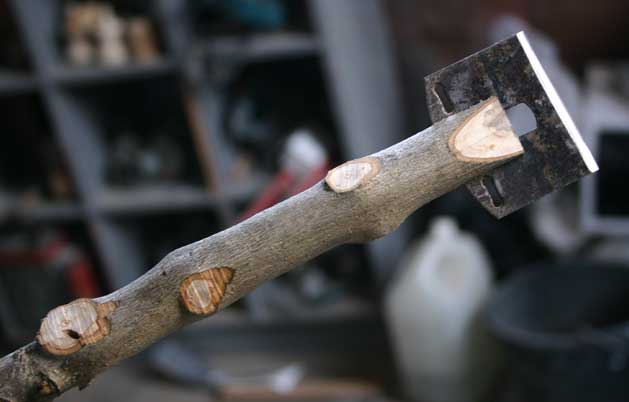
or
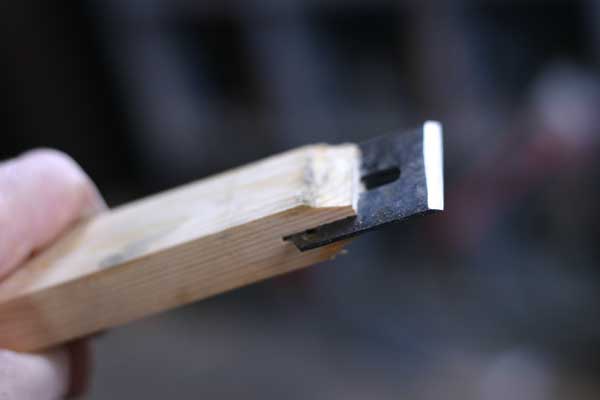
Simple to make and absolutely no point in ever buying one.
Little blades like spokeshaves are particularly difficult to hone with a Kell jig because like all the commercial jigs it has the same astonishing design fault, namely the absence of a handle or any convenient way to hold the tool/jig.
I'm always amazed by this as surely holding is the prime purpose of a jig, and it would be perfectly easy to design and make a jig with a handle. Why the F do they leave them off? :roll: Stranger still - why does anybody buy them?
This one is much better than the Kell jig and very convenient to use. You could use it in conjunction with one of the crazy commercial jigs and solve the holding problem, but it works quite well on its own.

or

Simple to make and absolutely no point in ever buying one.
dunbarhamlin
Established Member
Hey! That second one's a bit posh, Jacob 
I actually found the Kell a good set of training wheels before going almost entirly freehand for the very reason you dislike it.
Derek:
if using multiple bezels the micro bevel angle (shudder - a tautology) is the only one that really matters, and ideally should be as acute as the steel will bear for the job at hand. With few exceptions (e.g. (or is that i.e.?) mortise chisels) whether one uses multiple bezels is down to personal preference and has no effect on the tool's behaviour
If this is a fashionably thick modern cutter, then unless you have access to a powered grinding system it probably is worth using a secondary/micro bezel, as means only a thin strip of metal must be honed (the microbezel forming the cutting edge.)
If a normal thin cutter, then I don't think there is any great benefit.
If this is an A2 cutter you may want to use a micro bevel at a little over 30° - this to counter A2's reputed sub-par edge holding at more acute angles and greater resistance to abrasion.
Otherwise, yes, your suggested bevel is likely to be fine - try the tool at that, and adjust to a higher bevel if the edge doesn't hold up long enough in service.
I actually found the Kell a good set of training wheels before going almost entirly freehand for the very reason you dislike it.
Derek:
if using multiple bezels the micro bevel angle (shudder - a tautology) is the only one that really matters, and ideally should be as acute as the steel will bear for the job at hand. With few exceptions (e.g. (or is that i.e.?) mortise chisels) whether one uses multiple bezels is down to personal preference and has no effect on the tool's behaviour
If this is a fashionably thick modern cutter, then unless you have access to a powered grinding system it probably is worth using a secondary/micro bezel, as means only a thin strip of metal must be honed (the microbezel forming the cutting edge.)
If a normal thin cutter, then I don't think there is any great benefit.
If this is an A2 cutter you may want to use a micro bevel at a little over 30° - this to counter A2's reputed sub-par edge holding at more acute angles and greater resistance to abrasion.
Otherwise, yes, your suggested bevel is likely to be fine - try the tool at that, and adjust to a higher bevel if the edge doesn't hold up long enough in service.
Jacob
What goes around comes around.
Yes I thought it was worth putting in a bit more effort on the MkII.dunbarhamlin":1yfiz7w6 said:Hey! That second one's a bit posh, Jacob.....
I've slowly built up a little collection of rustic jigs - none of them having taken more than a few minutes to make. They are handy for small blades. Long thread here.
Paul Sellers has a few more in his book.
Richard T
Established Member
I shouldn't worry about precise measurement of angleage Derek. A secondary or micro bevel on the end of a 25 degree bevel gives more wiggle room than on the end of a 30 degree.
For any secondary bevel, my advice would be "a bit"; and with not many strokes ... let's say "a few".
For any secondary bevel, my advice would be "a bit"; and with not many strokes ... let's say "a few".
woodbloke
Established Member
Don't forget also that the Kell No2 likes to be used on the 'pull' stroke...in fact it's almost impossible to push it - Rob

£12.50 (£1.25 / count)
£14.45 (£1.44 / count)
JSP M632 FFP3moulded Disposable Dustmask (Box of 10) One Size suitable for Construction, DIY, Industrial, Sanding, dust protection 99 Percent particle filtration Conforms and Complies to EN 149
Amazon.co.uk

£19.99
Respirator Mask,Safety Dust Face Cover,Dust Face Cover Paint Face Cover,Gas Mask With Filter,For Paint,Dust And Formaldehyde,Sanding,Polishing,Spraying And Other Work
ShenZHEN CIRY MINGYANG LITIAN ELECTRONIC ECOMMERCE

£24.99
Facemoon Reusable Masks,Safety Masks,Dual Filter Masks, Paint, Dust, Epoxy Resin, Construction, Welding, Sanding, Woodworking, Chemical Reusable Gas Masks
ShenZHEN CIRY MINGYANG LITIAN ELECTRONIC ECOMMERCE

£234.08
£360.17
Trend Portable Benchtop Router Table with Robust Construction for Workshop & Site Use, 240V, CRT/MK3
Amazon.co.uk
David C
In Memorium
Almost all my blades are ground at 23 deg. The coarse stone and polishing stone angles are always about 2 degrees apart.
So for A2 paring chisels I might do 30 degree coarse & 32 degree polish. (In an Eclipse guide this means shorten projection by about 2 mm).
For chopping chisel, coarse 33 degrees, polish 35 degrees.
Get a wire edge on the coarse 800g stone, shorten projection a small amount, to raise honing angle a couple of degrees (just like the roller cam on the Veritas guide) take 4 gentle pull strokes on the polishing stone. Polish flat side to hone away wire edge.
If your spokeshave blade is carbon steel, i.e. not A2 you might try 27.5 degrees coarse stone and 30 degrees polish.
best wishes,
David Charlesworth
So for A2 paring chisels I might do 30 degree coarse & 32 degree polish. (In an Eclipse guide this means shorten projection by about 2 mm).
For chopping chisel, coarse 33 degrees, polish 35 degrees.
Get a wire edge on the coarse 800g stone, shorten projection a small amount, to raise honing angle a couple of degrees (just like the roller cam on the Veritas guide) take 4 gentle pull strokes on the polishing stone. Polish flat side to hone away wire edge.
If your spokeshave blade is carbon steel, i.e. not A2 you might try 27.5 degrees coarse stone and 30 degrees polish.
best wishes,
David Charlesworth
Jacob
What goes around comes around.
That's no good is it. Maybe my handle suggestion (above) would help here?woodbloke":3siri3r1 said:Don't forget also that the Kell No2 likes to be used on the 'pull' stroke...in fact it's almost impossible to push it - Rob
Another design defect is having the wheel outside the blade width so you probably have to buy bigger stones.
Basically it's a dead duck.
condeesteso
Established Member
All nice and well for a flat blade of course.
Now then, about the Millers cylindrical shave eh?... I mean that one where the blade is a part cylinder.
I might have a nifty (to me anyway) technique involving no jigs at all... Jacob will like that, surely?? Totally repeatable, single very narrow internal bevel just using the blade, stone of your choice and your bench / Workmate... and if you get posh, a scrap of 12mm mdf but that's optional and not used as a jig.
(I'll do some pics maybe.)
Now then, about the Millers cylindrical shave eh?... I mean that one where the blade is a part cylinder.
I might have a nifty (to me anyway) technique involving no jigs at all... Jacob will like that, surely?? Totally repeatable, single very narrow internal bevel just using the blade, stone of your choice and your bench / Workmate... and if you get posh, a scrap of 12mm mdf but that's optional and not used as a jig.
(I'll do some pics maybe.)
Jacob
What goes around comes around.
Sounds good. Bring it on!
condeesteso
Established Member
Will do Jacob. See, we do aim to please :lol:
woodbloke
Established Member
So you claim...actually it works rather well and is beautifully made, but it doesn't work on stones as the wheelbase is too wide, so w/d papers and 3M films are what it's best suited to - RobJacob":1ygfuwmu said:That's no good is it. Maybe my handle suggestion (above) would help here?woodbloke":1ygfuwmu said:Don't forget also that the Kell No2 likes to be used on the 'pull' stroke...in fact it's almost impossible to push it - Rob
Another design defect is having the wheel outside the blade width so you probably have to buy bigger stones.
Basically it's a dead duck.
condeesteso
Established Member
A quick side-track. Sorry Derek, but I'll get back on thread.
The MF spokeshave:
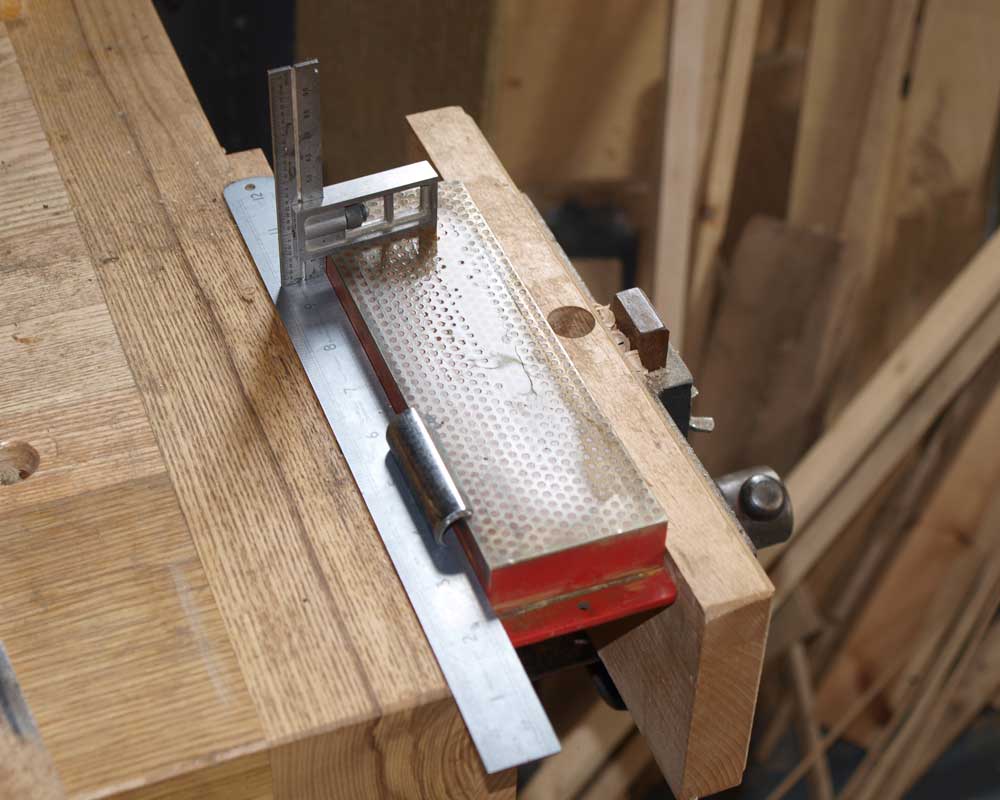
The stone is set 14mm up, but after a couple of strokes check where you are and adjust stone height if necessary. I found the inner bevel needs to be 1.9mm wide (I mean just under 2) to give an approx 30 degree bevel.
The outer was done by hand taking real care to keep it flat as any roll will upset the edge angle a lot.

[gratuitous product placement there #-o ]
And I use a small Kell for a few tricky chisels, like this Veritas detail 1/16th. I won't say it's the only or best way, but it is fast, accurate and repeatable. Each to our own.
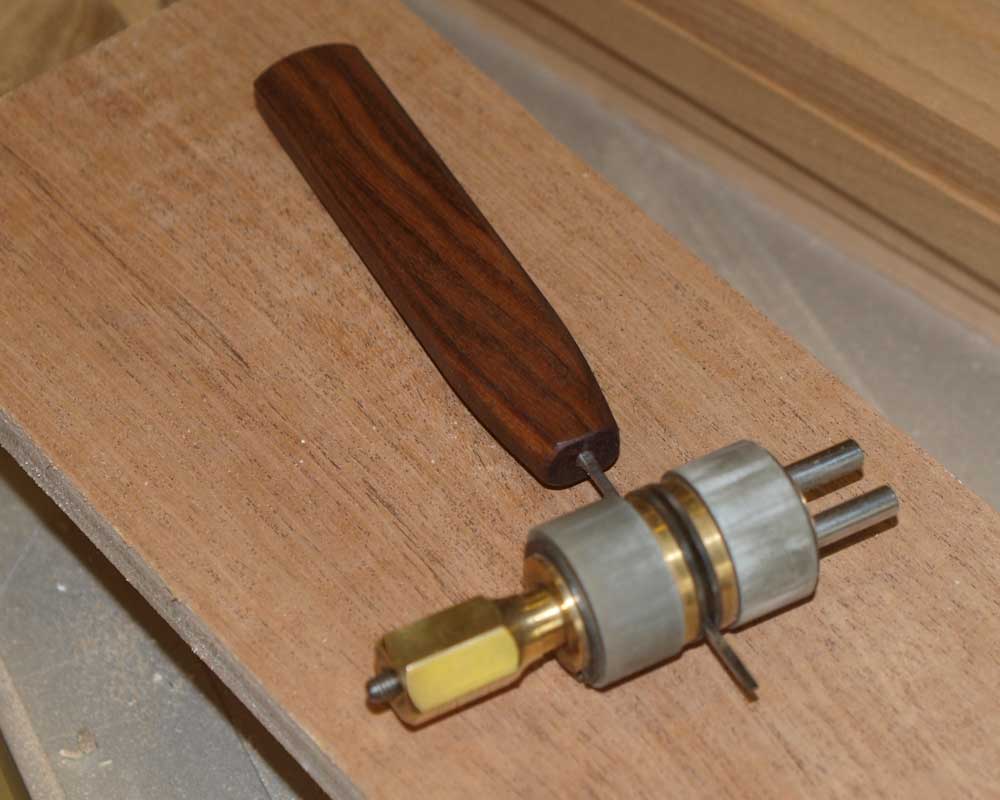
The MF spokeshave:

The stone is set 14mm up, but after a couple of strokes check where you are and adjust stone height if necessary. I found the inner bevel needs to be 1.9mm wide (I mean just under 2) to give an approx 30 degree bevel.
The outer was done by hand taking real care to keep it flat as any roll will upset the edge angle a lot.

[gratuitous product placement there #-o ]
And I use a small Kell for a few tricky chisels, like this Veritas detail 1/16th. I won't say it's the only or best way, but it is fast, accurate and repeatable. Each to our own.

Attachments
bugbear
Established Member
condeesteso":yet7wjk6 said:A quick side-track. Sorry Derek, but I'll get back on thread.
The MF spokeshave:
The stone is set 14mm up, but after a couple of strokes check where you are and adjust stone height if necessary. I found the inner bevel needs to be 1.9mm wide (I mean just under 2) to give an approx 30 degree bevel.
I think my way is simpler:
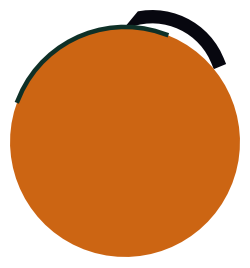
Just SiC abrasive wrapped around a pipe or rod. The blade self registers beatifully (just like a angle iron, used to rule along a cylinder)
Bevel is adjusted by diameter selection (essentially, the first time time you do this, you find which pipe works...)
BugBear
Jacob
What goes around comes around.
So it's difficult to hold (not good for a "holding" device). it only works backwards, won't work on normal sized stones and is very expensive.woodbloke":1hwg3uge said:So you claim...actually it works rather well and is beautifully made, but it doesn't work on stones as the wheelbase is too wide, so w/d papers and 3M films are what it's best suited to - RobJacob":1hwg3uge said:That's no good is it. Maybe my handle suggestion (above) would help here?woodbloke":1hwg3uge said:Don't forget also that the Kell No2 likes to be used on the 'pull' stroke...in fact it's almost impossible to push it - Rob
Another design defect is having the wheel outside the blade width so you probably have to buy bigger stones.
Basically it's a dead duck.
But otherwise excellent?
Hmm, not convinced.
Emperor's new clothes again! :lol: :lol:
Similar threads
- Replies
- 19
- Views
- 2K
- Replies
- 4
- Views
- 1K
- Replies
- 4
- Views
- 860






























